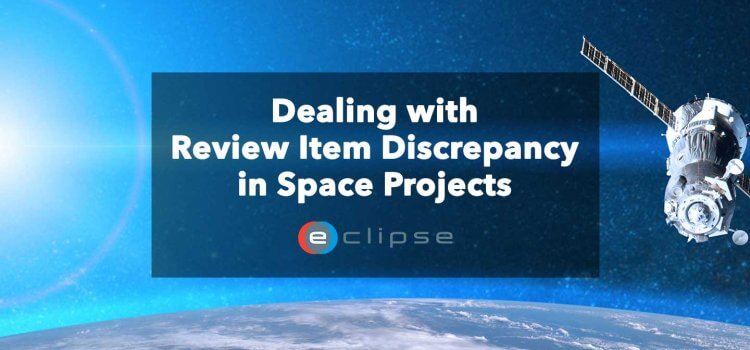
External Technical Reviews: How ECLIPSE can help you
02 Apr, 2025
In space projects, every component and decision has to meet strict standards. That’s where external technical reviews come in. External technical reviews are independent assessment processes where teams validate the technical integrity of a project, often involving reviewers from outside the immediate team or organisation. A technical review ensures that everything checks out technically, safely, and operationally.
However, managing these reviews can be challenging, especially when teams rely on outdated tools like spreadsheets or email threads. That’s where the eRID (Review Item of Discrepancy) system steps in.
The old way: Unstructured and error prone for team
Managing an external technical review often means juggling information across multiple teams and systems. Spreadsheets, email updates, and shared folders create confusion and delay important decisions. Teams waste time tracking comments and actions. Worst of all, critical issues might slip through unnoticed. For space missions, that’s not a risk worth taking.
The new way: Review management with eRID
eRID (Review Item of Discrepancy) offers a digital platform that brings structure and clarity to external reviews. It is a tool used to manage and track reviews in a structured way. Instead of chasing files across different tools, everyone works from the same central hub. All review items, comments, and decisions are visible to the right people, at the right time. That transparency boosts confidence and speeds up the entire process.
Structured review management
Open – Release – Submit – Close – Void is a common and effective structured workflow for managing technical reviews. It is especially used within the space and aerospace projects where traceability and compliance (e.g., ECSS) are essential. Here’s a quick breakdown of how each stage typically functions in tools like ECLIPSE’s eRID module:
- Open: The review process begins with the Open phase, where a Review Item of Discrepancy (RID) is created. At this stage, the originator inputs the initial data such as the title, description, and associated documents. The RID is in draft status and can be edited by authorized users.
- Release: Once the RID is complete and ready for consideration, it moves to the Release phase. Here, the entry is validated for completeness and available for review panels or board members. This signals that the RID is prepared for formal evaluation.
- Submit: In the Submit phase, the RID is officially submitted to the designated review board or technical panel. Participants can now review the content, add comments, request changes, or provide technical assessments. The RID remains under review until a formal decision is made.
- Close: Following deliberation, the RID enters the Close phase. This indicates that a resolution has been reached, such as approval, rejection, or implementation of changes. Any resulting actions are tracked and logged, ensuring full traceability and compliance.
- Void: Alternatively, if the RID is deemed irrelevant, duplicated, or created in error, it enters the Void phase. This status requires justification and maintains the RID within the system for audit purposes while marking it as inactive.
From the moment the review is started to final approval, eRID supports every step. It logs every comment, tracks every decision, and assigns responsibilities. Whether you’re working on one mission or across multiple projects, the process stays clear and consistent.
Easy access: All data in one place, always up to date
With eRID, review participants can access everything they need from one interface:
- Deliverable data packs (bundled technical documents submitted for formal review)
- Technical or contractual baselines (agreed reference points that define system requirements or project scope)
- Requirements documentation (detailed descriptions of what the system or component must achieve)
This means less time searching for files and more time solving real problems. It also helps reviewers feel confident in the data they’re using to make important decisions.
Real-time reviews: Work faster with better collaboration
eRID gives users role-based access, so each person sees what matters most to them. Teams can:
- Filter and sort relevant RIDs
- Comment directly in the platform
- Take and give actions within the review sessions
That kind of agility is essential for fast-paced engineering teams spread across locations and time zones.
Built-in follow-up: Automated reminders that keep things moving
eRID’s notification system prompts timely actions without anyone needing to chase. Reviewers get reminders automatically, keeping the process on track without extra admin work. That means fewer delays and smoother progress.
Fits right in: Works with your existing project tools
eRID doesn’t sit in a silo, it is connected with the other ECLIPSE Software Modules. It connects with the tools you already use to manage project timelines, actions, and deliverables. That seamless integration keeps your workflows clean and consistent from start to finish. Contact us to learn more about the integration with your tools.
Why it works: Quality, speed, and traceability
With eRID, external technical reviews become more robust and efficient:
- Quality: Standardised input and clear ownership prevent mistakes.
- Speed: Everything’s in one place, so there’s less rework and faster decisions.
- Traceability: Every action, from the first comment to the final sign-off, is recorded and easy to track.
Ready to modernize your review management?
If your external technical reviews still rely on spreadsheets and scattered updates, it’s time to change. eRID brings structure, speed, and clarity to one of the most critical parts of space project development. Want to see how it works in practice? Book a demo and discover a better way to manage formal reviews.



